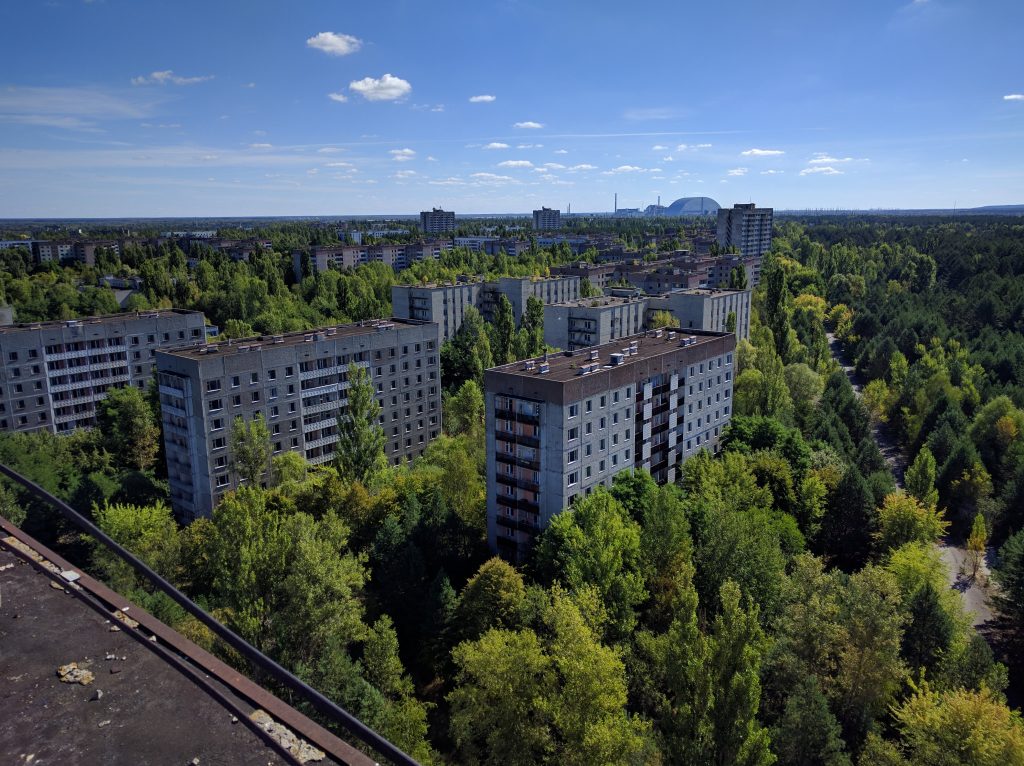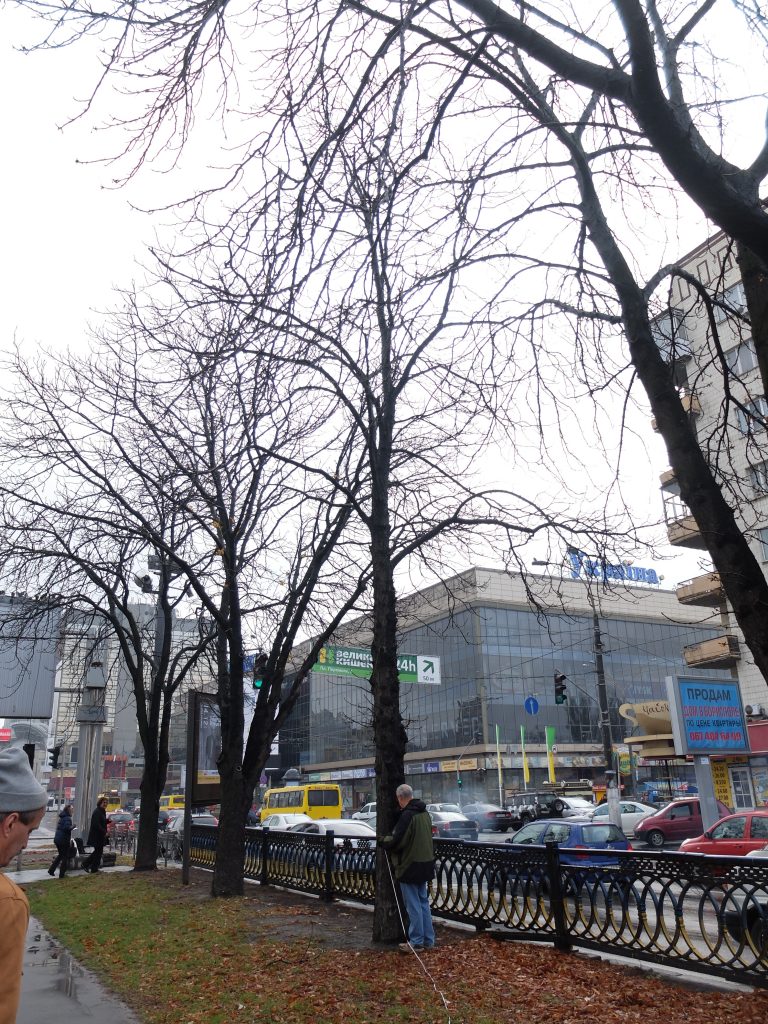Ukraine is all in the news these days as Russian troops are amassed along its borders in Belarus and neighboring Russia. I have some knowledge of Ukraine having visited the Chernobyl nuclear exclusion zone (the “Zone”) four times in 2012, -15, -16 and 2018. I had planned more visits but the global COVID-19 pandemic prevented my return to Ukraine and the Zone. The accident at Chernobyl was the worst nuclear accident in the history of mankind releasing more radio isotopes than the event at Fukashima and had long ranging impact on Ukraine and the then Soviet Union. Some say that the event precipitated the down fall of the former Soviet empire.

Today the Chernobyl Nuclear Power Plant (CNPP) remains one of the most radioactive places that you can safely visit in the world. It was also the source of most of the world’s background radioactivity. When the disaster occurred in 1986, it temporarily raised the background gamma radiation of the entire planet by two percent. This rapidly declined as the half life of the released gases is very short and their radioactivity went away a few days and months later. Some of the elements, like radio Cesium 137 and Strontium 90, have longer half lives (around 30 years) and there was enough of them released to maintain high levels or gamma radiation where the fallout was most concentrated around the power plant. Elements such as plutonium remain radioactive for thousands of years but the amount of plutonium released was much less than that of strontium or cesium. Today the background gamma radiation near the CNPP remains up to ten times greater than the normal background levels found in the Ukraine capitol of Kiev. So how has this affected the gardens of Pripyat, the workers town not less than a km from the CNPP? To get to that let’s first talk more about the worker’s town and the disaster and then move on to what happened to the horticulture years later.
When the reactor exploded in 1986 (and yes it actually exploded) the area was surrounded with an exclusion zone complete with military checkpoints at 10 and 30 km circles away from the CNPP. This was an effort to keep people away from the radiation. The town that held the CNPP workers is Pripyat. It was a modern city of about 50,000 residents. It was considered the model city of its day as Chernobyl was considered the pinnacle of energy producing technology. Pripyat had a performing arts center, sports stadium, nightclubs, libraries several schools, public pool, and an amusement park. The entire population of the town was evacuated by bus in April 1986 in a few days. Although they were told they would return, most never did. Prypiat fell into ghost town status and remains that way to the present day, and like most ghost towns it was heavily looted. Some recent reports suggest that the Ukraine military has been knocking down buildings recently. Like any well planned city, Prypiat had an urban forest plan, street trees on every avenue and boulevard and gardens with ornamental plants. All were abandoned in 1986 and left to rainfall, radiation and the animals that remain there today.

The forest returned vigorously to Pripyat and animals roam the streets. The ecosystem recovery in the Zone has been dramatic over thirty years. Remnant street tree populations remain along the avenues but many more wild and non native exotics have invaded the spaces. The once athletic stadium playing field is now a small forest.

The forest encroachment has had a devastating impact on the architecture of the remnant buildings. Trees grow everywhere and when they attack the buildings they are able to collapse the floors and walls effectively demolishing the structure.

People have great impacts on the health and structure of trees. When left alone they develop their own natural structure according to their genetic code. Over several visits we measured growth of trees in the Zone and took pictures to analyze their structure. We found that trees of similar age growing in Pripyat were smaller in size but had better branch structure due to LACK of pruning for 30 years.


It is hard to imagine what the gardens of Pripyat looked like at the time they were in cultivation because we have so few records of the city to review. There are the remnant street trees which my friend Igor Lacan studied extensively. Garden plant remnants are mostly gone except for extant rose bushes which can still be found around the city.

It is hard to know what the gardens could have become before the forest invaded the city. We can look at landscapes in Kiev that exist today and see the overall gestalt of Ukraine gardens. They are kind of wild not meticulously maintained in public spaces but they also have charm, character and beauty.


As Ukraine is on the brink of uncertainty there are a few things that are certain, the radiation in the Chernobyl nuclear exclusion zone will continue, people will likely not be allowed to travel freely there, and the trees will continue to grow. The fate of gardens and trees in the capitol city of Kiev is less certain.
References:
Lacan, I., J.R. McBride, and D. De Witt. 2015. Urban forest condition and succession in the abandoned city of Pripyat, near Chernobyl, Ukraine. Urban Forestry & Urban Greening 14.4:1068-1078.
Burlakova, E.B. and V.I. Naydich (eds). 2012. The Lessons of Chernobyl: 25 Years Later. Nova Science Publishers, N.Y.
Downer, A.J. and J.F. Karlik. 2019. “A Comparison of Two Horsechestnut Street Tree Plantings in Kiev and Pripyat, Ukraine.” Open J. Forestry 9: 255-263.
Karlik, J.F. and A.J. Downer. 2019. Comparison of Gamma Ray Dosimeters in a Field Study in the Chernobyl Exclusion Zone. J. of Air and Waste Man. 11:1361-1367
Thank you Dr Downer for Post I will definitely put some time to read .
Ralph Villaseñor
Is there any evidence of radioactive changing the growth patterns of trees and plants in Chernobyl?
Hi Ravi. Yes. Gamma radiation is toxic to plants when at high levels say 20G. this is enough to kill scotts pine. Residual gamma radiation from radio cesium has also been linked to growth reductions in Scotts pine.